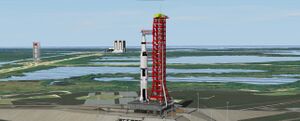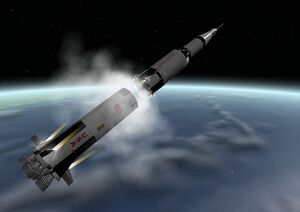Saturn V: Difference between revisions
imported>Mark Grant No edit summary |
imported>Graham2001 m (Reverted edits by AcaceLrovi (Talk); changed back to last version by Tschachim) |
||
| (8 intermediate revisions by 5 users not shown) | |||
| Line 11: | Line 11: | ||
==Stages== | ==Stages== | ||
The rocket | The rocket consists of three stages. The [[S-IC]] has five [[F-1]] engines, burning liquid oxygen and kerosene, the [[S-II]] stage mounted above that has five [[J-2]] engines, burning liquid hydrogen and oxygen. The [[S-IVB]] stage has one J-2 engine, and is responsible both for the final part of the launch to put the spacecraft in orbit, and for the [[TLI]] burn to boost them on a trajectory that will take them to the Moon. | ||
Between the stages are two interstage structures. The S-IC/S-II interstage is a metal cylinder which holds a number of ullage rockets and covers the J-2 engines for the initial stages of the launch; this interstage remains attached to the S-II stage until it has reached a safe separation from the S-IC, when it is jettisoned. Because the S-II has multiple engines, there is a risk that one or more engines could fail or run at much lower thrust than the others, so that the engines would collide with the interstage if | [[Image:Screenshot SaturnV First Staging 1.jpg|thumb|right|S-IC/S-II staging]] | ||
Between the stages are two interstage structures. The S-IC/S-II interstage is a metal cylinder which holds a number of ullage rockets and covers the J-2 engines for the initial stages of the launch; this interstage remains attached to the S-II stage until it has reached a safe separation from the S-IC, when it is jettisoned. Because the S-II has multiple engines, there is a risk that one or more engines could fail or run at much lower thrust than the others, so that the engines would collide with the interstage if it remained attached to the S-IC stage. Taking the interstage with the S-II at ignition ensures that by the time the interstage is jettisoned the rocket will be in a stable trajectory and the engines should all be running at full thrust, minimising the chance of collision and damage. The S-IVB only has one engine, so the S-II/S-IVB interstage remains attached to the S-II; either the engine will work or it won't, so there's little risk of a failure causing a collison between the stages. | |||
In both cases, retro rockets on the spent stages push them away from the stage that is about to ignite, while solid-fuelled ullage rockets on the S-II and S-IVB burn for a few seconds both to increase separation between the stages and to settle the fuel in the tanks ready for engine ignition. For the TLI burn, the S-IVB liquid-fuelled APS thrusters are used for the ullage burn prior to ignition. | In both cases, retro rockets on the spent stages push them away from the stage that is about to ignite, while solid-fuelled ullage rockets on the S-II and S-IVB burn for a few seconds both to increase separation between the stages and to settle the fuel in the tanks ready for engine ignition. For the TLI burn, the S-IVB liquid-fuelled APS thrusters are used for the ullage burn prior to ignition. | ||
Latest revision as of 13:12, 1 November 2007

The Saturn V (pronounced 'Saturn Five,' popularly known as the Moon Rocket) was a multistage liquid-fuel expendable rocketSATURNV_FLIGHTMAN used by NASA's Apollo and Skylab programs.
Background
The largest production model of the Saturn family of rockets, the Saturn V was designed under the direction of Wernher von Braun at the Marshall Space Flight Center in Huntsville, Alabama, with Boeing, North American Aviation, Douglas Aircraft Company, and IBM as the lead contractors. It remains the most powerful launch vehicle ever brought to operational status, from a height, weight and payload standpoint, although the Russian Energia, which flew only two test missions, had slightly more takeoff thrust.
Stages
The rocket consists of three stages. The S-IC has five F-1 engines, burning liquid oxygen and kerosene, the S-II stage mounted above that has five J-2 engines, burning liquid hydrogen and oxygen. The S-IVB stage has one J-2 engine, and is responsible both for the final part of the launch to put the spacecraft in orbit, and for the TLI burn to boost them on a trajectory that will take them to the Moon.

Between the stages are two interstage structures. The S-IC/S-II interstage is a metal cylinder which holds a number of ullage rockets and covers the J-2 engines for the initial stages of the launch; this interstage remains attached to the S-II stage until it has reached a safe separation from the S-IC, when it is jettisoned. Because the S-II has multiple engines, there is a risk that one or more engines could fail or run at much lower thrust than the others, so that the engines would collide with the interstage if it remained attached to the S-IC stage. Taking the interstage with the S-II at ignition ensures that by the time the interstage is jettisoned the rocket will be in a stable trajectory and the engines should all be running at full thrust, minimising the chance of collision and damage. The S-IVB only has one engine, so the S-II/S-IVB interstage remains attached to the S-II; either the engine will work or it won't, so there's little risk of a failure causing a collison between the stages.
In both cases, retro rockets on the spent stages push them away from the stage that is about to ignite, while solid-fuelled ullage rockets on the S-II and S-IVB burn for a few seconds both to increase separation between the stages and to settle the fuel in the tanks ready for engine ignition. For the TLI burn, the S-IVB liquid-fuelled APS thrusters are used for the ullage burn prior to ignition.
Variants
A number of alternate Saturn vehiclesSATURNV_STUDIES were proposed based on the Saturn V, ranging from the Saturn INT-20 with an S-IVB stage and interstage mounted directly onto an S-IC stage, through to the Saturn V-23(L) which would not only have five F-1 engines in the first stage, but also four strap-on boosters with two F-1 engines each: giving a total of thirteen F-1 engines firing at launch!
<biblio force=false>
</biblio>